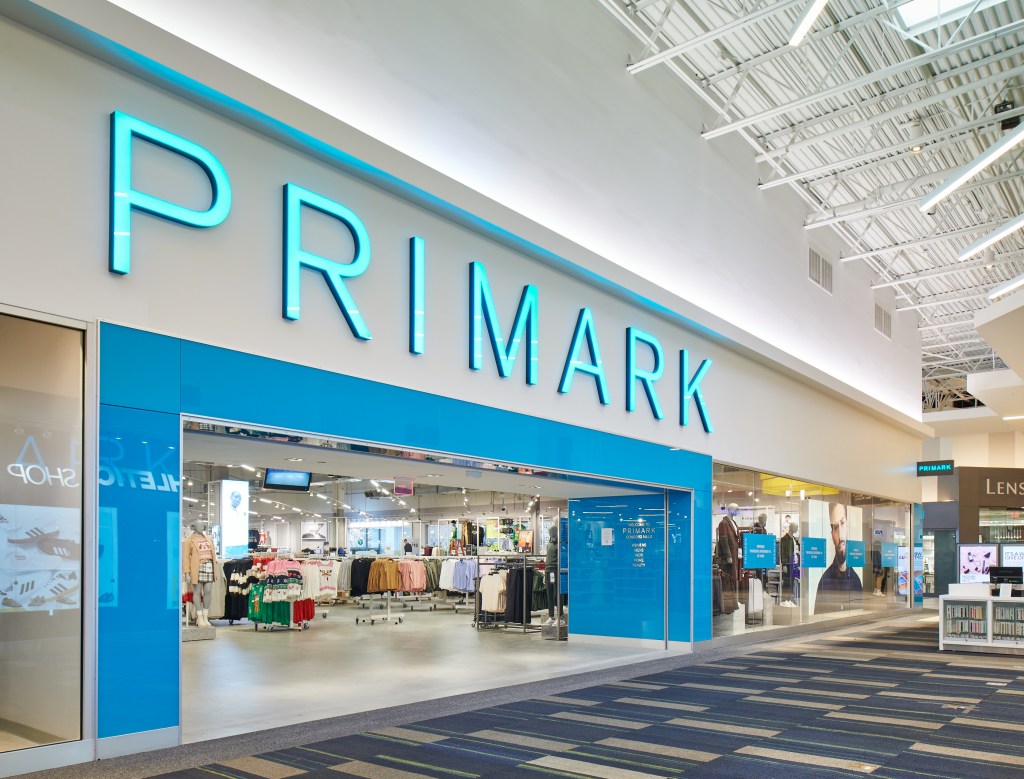With its deepening expansion in the U.S., Primark won’t be pigeonholed.
The Dublin-based Primark typically aims for sites with roughly 35,000 square feet of selling space, 50,000 square feet gross. But as Kevin Tulip, the president of Primark U.S. and a 22-year veteran of the company, says, “We’re continuing to keep an open mind about other opportunities. With trial and testing, we will continue to push the boundaries of what Primark can look like. We’re still very early in this expansion journey in the U.S. and I certainly don’t want to stop ourselves from pushing on.”
More than a decade ago, when Primark disclosed plans to enter the U.S., Americans asked, “What’s Primark?” With virtually no brand recognition in the States, Primark has been converting vacated stores into its own since 2015 with its first U.S. store opening in Boston, which is also where Primark U.S. is based. Primark operates 24 stores in nine states, and is on track with its U.S. expansion strategy.
“We’re still very firm on our store opening plan of 60 stores by 2026. We’ve got a big build ahead in terms of store openings,” Tulip said during a wide-ranging interview at the Primark store inside the City Point mixed-used development in downtown Brooklyn. At three levels and with 49,000 square feet of selling space, the store, a former Century 21 flagship, is the second-largest among Primark’s U.S. stores, next to the store in Kings Plaza in Brooklyn, which has 58,000 square feet for selling.
The stores are filled with $3.50 bikini tops, $22 jeans, $10 men’s chino shorts and $16 girls tutu dresses, among the vast array of fashion items at rock-bottom prices. It’s hard to find anything over $50, except some outerwear and luggage. In Europe, Primark, which is owned by Associated British Foods, has 441 stores in 16 countries.
In the following Q&A, Tulip provides a progress report on Primark’s U.S. expansion, its challenges and opportunities, and why Primark sees an opening in the already crowded field of mass merchants, off-pricers and value-oriented department stores. Considering its offer and what’s been accomplished so far with the expansion, Primark is beginning to grab some market share from the likes of Old Navy, Walmart, Target and The Children’s Place, as well as off-pricers.

WWD: Does Macy’s plan to close 150 stores over the next few years pose an opportunity for Primark to grab certain sites?
Kevin Tulip: It does. We’ve been very clear about the locations where we see Primark as being viable. We’ve got 24 trading today. We continue to sign leases. Our stores average 50,000 to 55,000 square feet gross so most of the Macy’s locations are far bigger, clearly. But certainly if the location was right for us, we’d be interested.
WWD: Have you looked at any Macy’s at this point?
K.T.: No, because for us it’s the location, first and foremost, and then what space is available. In fairness, there’s not been a Macy’s location available so far. If it’s the right location, and on our roadmap, we’d be interested. We stalk malls all the time. When I’m traveling, I’m spending two, three days a week in our current trading stores. But I’m always looking at what else is out there, dropping into malls, checking space out and looking at foot traffic, at the competition, and everything in between.
WWD: Aside from Macy’s, what are other takeover opportunities?
K.T.: With the first stores we opened, it was a group of Sears that we took. Actually, Sears locations are still coming up. There’s also been a couple of JCPenney’s we’ve moved into. But I’d say Sears has probably been the more frequent one that’s come up. We usually take one floor of what was a two-floor Sears.
WWD: What’s the store opening plan for this year?
K.T.: We’ve got five stores opening: Tysons Corner in Virginia, Florida Mall in Orlando, Great Lakes Crossing just outside of Detroit, then Queens Center in New York, and around the holidays we should open our first store in Texas, at La Plaza mall in McAllen on the Mexican border. We’ll also be opening in El Paso in early 2025.
WWD: How flexible are you in choosing locations?
K.T.: Great Lakes is a fairly outlet-oriented mall. We just signed two more Mills locations, Katy Mills in Texas and Potomac Mills in Virginia. Definitely, we are very encouraged by the outlet-style mall. We’re so early still in our expansion that we’re certainly not saying exactly what works for Primark and there’s nothing else. We like to think we’re pretty well-versed in the regional mall at the moment, but we’re going to continue to push and see what works for us. I am not going to let us be pigeonholed. We talk a lot about 35,000 square feet [selling space] working well for us, but we’re not locked into that. We’ve been looking at stores of varying size. We’re going to try some smaller formats. If something bigger came up, we’re not averse to it. It’s very much about location first.

WWD: What states will you be entering in the next couple of years?
K.T.: We’ve got Texas that will be opening in 2024. Virginia, actually, for Tysons Corner is a brand new state for us when we get there later in the summer. We just announced our first store in Tennessee just outside of Nashville, in Cool Springs. It will be probably be the end of ’25 by the time we get that open. And obviously Michigan later this year will be another new state for us as well. So we’re currently in nine states and will be in 11 by the end of the year. And we’ve got another three or four states coming up next year. Those leases will be announced. I can’t mention those states.
Geographically, we are very much in the Northeast, Southeast, Midwest and Texas. We haven’t made any move further west yet. We’ve got a distribution center up in Bethlehem, Pa., which gives us great coverage around the Northeast into the Midwest, and we just opened our second distribution center in Jacksonville, Fla., [to service] the Southeast and Texas. In Florida, for example, our Sawgrass Mills store for awhile has been trading exceptionally well. So you’d think we’d go after plenty of space in Florida and we will, but it’s about identifying the right space. At some malls in Florida we want to be in, there isn’t the right space available today.
WWD: What’s the criteria for opening a store in a particular location?
K.T.: We look for a mall with preexisting foot traffic, a healthy set of similar retailers, and we like to see some entertainment, whether that’s a cinema or another form of entertainment, and that’s actually why our Mills locations do well. They have a really good element of cinemas, Rainforest Cafes, things that draw people in, in addition to the shopping. After that, it’s the look and feel of the mall. What’s the investment and the upkeep in the mall like? And then it’s down to the space, the location within the mall, and the adjacencies to that space. What is the competitive fashion set in there? Our price point is quite similar to off-price, although our model is not off-price. So you know that value-driven customer is great to see. So no harm in terms of sharing space with those off-price retailers. They’re clearly driving significant foot traffic. And then if you’ve got the entertainment aspect, it’s great for us to pick up that evening trade.

WWD: How would you characterize the pace of Primark’s U.S. expansion?
K.T.: We’ve been in the U.S. since 2015. In the early years, we had a small number of stores getting built. It’s only been since 2021 that we’ve really started to stretch our legs. We’ve added a significant amount of stores, retail square footage and personnel in the last 12 months. The malls we’re going into are humongous, particularly compared to the malls in Europe we’re in.…The growth in the U.S. will continue to be cautious [though] we’ve hit the accelerator. But there’s still criteria and characteristics we’re not willing to forget just for the sake of growth.
WWD: How long does it take to launch a store in the U.S., from determining a good site to getting it open for business?
K.T.: Probably two to three years depending on the location. It depends on what that store was before and how much work is needed in terms of the shell. From a cost, efficiency and environmental standpoint, we love to get into a space where we can keep some of what’s already there. It really depends. You can imagine that a Sears location closed for awhile would [require] significant work. In other locations, like here, where it was Century 21, some of the lighting and infrastructure was not that old. We would maintain as much of that as possible. But we have high standards in terms of the fit out, and what we want the store to look and feel like.
WWD: What was the toughest store to open in U.S. so far?
K.T.: Probably Jamaica Avenue by 162nd Street in Queens, because that was actually numerous retail spaces. There was a lot that went into making that into Primark. When you’ve got to do that amount of work in a very dense urban area, it’s tough. But the relationship we had with the landlord was incredible and we have a team at that store all from the local area. When we opened, we did a lot of work in the community with local schools. We’ve been welcomed with open arms and we have a very frequent customer. Our customer on Jamaica Avenue shops more like our customer in Europe, more regularly, whereas in some malls, people visit less frequently. It’s a very different trade pattern we see in malls and in some downtown locations. Jamaica is our first and only true neighborhood store.
WWD: The U.K. is Primark’s largest market with 192 stores. Could the U.S. become Primark’s biggest market?
K.T.: With a run of 60 stores planned for 2026, it’s not completely outside of the realm that the U.S. one day could be called the biggest.
WWD: When Primark announced its U.S. expansion, the reaction was, does the U.S. need another value-oriented retailer. What’s your response to that?
K.T.: It’s a good, healthy, challenging question that we ask ourselves. You know, part of our culture is around super challenging ourselves. It’s not about just spending all our time thinking about the future. It’s about understanding and learning what’s happening every single hour of every single day, obsessing over every element of the in-store experience, yesterday’s results, this week’s results and every product of every size availability. We’re unique in terms of price point, fashionability, quality and sustainability. There’s a gap in the market for that. We’re pretty clear around the uniqueness of our model and our product….When we think about brand awareness, growing and about a marketing strategy, we will need to evolve and think differently. There’s not a lot of people shopping malls in Texas who experienced Primark before. We’ve relied a lot on word of mouth. But when we think about a marketing strategy, it needs to look and feel quite different. Once people experience us, they’re surprised the price points look and feel quite similar to an off-price retailer. But actually the product is this season’s fashion.

WWD: Isn’t the landscape overcrowded with off-pricers and value retailers?
K.T.: When we think about similar types of retail, the Walmarts, the Targets, Zara, H&M, there’s a healthy competitive set. Of course, everyone’s got their unique elements and their own product ranges. But we don’t feel we’re trying to shoulder into a crowded field. We’re pretty confident in the product we’ve got and its uniqueness.

WWD: Americans are used to coupons, markdowns and high-low pricing. Primark’s pricing is quite different, so is it like everyday low pricing?
K.T.: In the U.S. for a long time, the view has been that retail is about deals. You don’t know what the price is going to be from one day to the next. Our pricing structure is very clear. The first price is the right price. When we bring a product in, we’ve done all the hard work to get that product in at that price. It’s not going to be “buy one, get one free” that afternoon. It’s not going to be up to 70 percent off randomly next week. You won’t see a President’s Day weekend sale. That’s not how we operate. Yes, we have some markdowns and we’ll do some clearance items. But if we bring in a T-shirt, it’s $4.50 and that’s the best price for that T-shirt. The work has already been done to deliver that. That is quite different to what’s existed in the U.S. Every single day at Primark, you see amazing product at [one] price — and you can trust it. It’s the pricing model you’ll see in every country we’re in. It works the same everywhere. When we have a markdown or a clearance, it’s very much the last bit of that product for the season.
WWD: Has it been a steep learning curve for Americans to get to know Primark?
K.T.: Definitely, and we’ve still got work to do to bring that to life. We see a lot of repeat customers now in stores we’ve opened, whether it be for ladies’ fashion, men’s fashion, kids, for basics, footwear, accessories, whatever it may be. Still, when entering a new market, that’s where we need to continue to learn and think about how we bring our message out there.
WWD: How do you market your stores?
K.T.: We don’t do TV ads and we don’t have a transactional website. We’ve stayed away from the expense around traditional marketing. A person’s first experience with Primark might be the QR code to scan on a temporary wall of a store being built in a mall. We’ve had some very creative marketing within social [media] and with influencers based in regions where we are opening stores. It’s really an organic build. Word of mouth has been powerful. Primark’s brand awareness in Europe is incredibly strong. In the U.S., it’s building but there’s still relatively low levels of brand awareness. So the marketing strategy for the U.S. might look different, long term, than for Europe.
WWD: What are you selling a lot of these days?
K.T.: Licensed products. We’ve had recent collaborations with the NBA and NFL, and we’ve had some great success across Disney. We’ve also seen a real pick up in some everyday basics, like men’s and ladies leisurewear. Whether it’s a hoodie, a crewneck sweater or a pair of joggers [sweatpants]. We’re talking about a $9 price point on men’s joggers and $10 on ladies’ leggings. We’ve had an incredible reaction in ladies’ swim, within the first two weeks, with an entry price point of $3.50 for a separate bikini top or separate bikini bottom.
We have a big collaboration with Rita Ora. We’re in the third phase [for spring, following fall and holiday 2023]. It’s in our trend area, so we would locate it at the street entrance. Rita had been shopping with us since she was very young and still loves the brand. There’s this level of authenticity that comes with the collaboration. Some other collaborations have been very much around U.K. personalities who, again, shopped with Primark for a long time. We also have Kem from the U.K. from the British reality show “Love Island.”
WWD: What’s your view on the consumer in 2024?
K.T.: It’s about customers continuing to seek out value, in a huge way. Obviously, we faced a lot of pressure on inflation, which has cooled, and we’re well aware of the rise in credit card debt, and there’s a lot of noise around student loans. There’s an element of uncertainty that, of course, [which relates] to being an election year. From what we see, more and more customers are looking for value.
I do hate the words “trading down,” but maybe people are trading down, maybe out of necessity stepping into a Primark store that they hadn’t stepped into before. And I think there’s an element that they find the look and feel of the place very different from maybe what was imagined.




